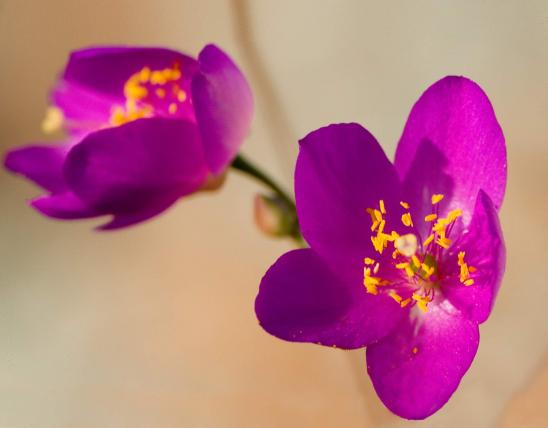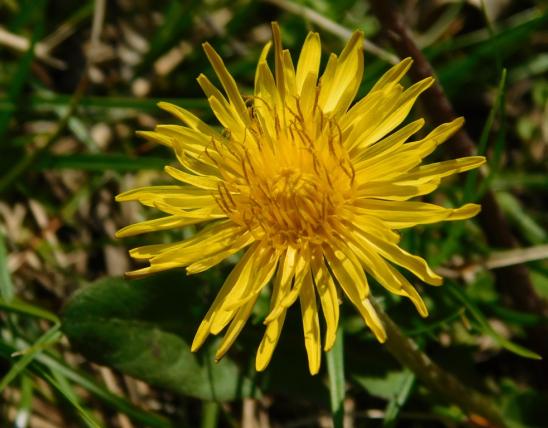
Purslane is an annual, succulent plant, with taproot and fibrous side roots. It forms a branching, spreading mat on the ground up to about 2 feet wide and about 6 inches tall. With its fleshy stems and leaves, it resembles a miniature version of the common houseplant known as jade plant.
Stems are round in cross-section, thick, succulent, and hairless, green to reddish green.
Leaves are alternate, usually about 1 inch long, about ½ inch wide, flattened, spoon-shaped or reverse-egg-shaped (widest above the middle).
Flowers June–November, in small, dense clusters, lacking conspicuous hairs. Petals 4–6, less than ¼ inch long, yellow. Stamens usually 6–12.
Fruits are egg-shaped, about ¼ inch long, splitting at maturity in a circle around the middle to release numerous small, brown to black, kidney-shaped seeds.
Similar species: Two other species of Portulaca have been recorded as occurring in Missouri.
- Portulaca, also called moss rose and rose moss (P. grandiflora), is native to South America but is commonly grown as a bedding plant in flower gardens. It can escape cultivation and persist in places like river banks, railroads, roadsides, and sidewalks. It has linear leaves that are mostly round in cross-section; stems that are sometimes hairy toward the tip; tufts of hairs in the leaf axils; and showy flowers that may have a wide range of colors. Some cultivars have doubled petals. The petals are about ½–1 inch long.
- Pink purslane, hairy purslane, or kiss-me-quick (P. pilosa) is a native growing scattered in the southwestern portion of the state north to Jackson County; it is uncommon and sporadic farther east. It grows in glades, sand prairies, ledges and tops of bluffs, railroads, roadsides, and other open, disturbed areas. Its leaves and stems are similar to P. grandiflora, but its petals are only about ¼ inch long and are red to reddish purple. (Botanical synonyms include P. mundula and P. parvula.)
By the way, the houseplant called jade plant (Crassula ovata) is in a different family (the Crassulaceae; the stonecrops, orpines, or sedums). It does not survive winters outdoors in Missouri.
Stem length: 2 to 20 inches.
Scattered to common statewide.
Habitat and Conservation
Occurs primarily in open, disturbed areas: banks of streams and rivers, margins of ponds, lakes, and marshes, seeps, bases, ledges and tops of bluffs, upland prairies, and glades; also crop fields, fallow fields, ditches, gardens, lawns, sidewalks, railroads, and roadsides.
For many years, botanists believed this species was probably introduced to North America from the Old World, but more recent evidence has pointed to the idea that this plant has an ancient, cosmopolitan (worldwide) distribution: Some of the earliest explorers in the Americas found the plant already growing, and seeds of this plant have been found in archaeological sites and in sediment cores from times before European colonization.
Status
Common native plant, considered both an agricultural pest and home-garden weed as well as a cultivated vegetable and trendy microgreen.
Human Connections
The bad news is that common purslane is considered among the worst agricultural weeds in the world and can become an aggressive pest in gardens. This creeping plant is often lower than a lawnmower blade, but the stems often spread out a foot or more from the center of the plant, shading out surrounding plants. Once established in an area, it can be hard to eradicate. Anyone who has battled purslane can’t help but laugh at someone who propagates it.
The good news is that common purslane has a long history, worldwide, as a cultivated vegetable. Recently, it has become a trendy “new” food. We now recognize it as a superfood: it’s high in Omega-3 fatty acids (ALA and LNA), antioxidants, potassium, magnesium, calcium, manganese, iron, Vitamins A and D, and more. Calorie for calorie, it’s one of the most nutrient-rich foods on earth. Considering that it grows for free, it’s much less expensive than buying salmon for your Omega-3s.
One note of caution, however: Because, like spinach or sorrel, purslane contains high amounts of oxalates, you should not eat too much at a time, and people who have kidney stones or other kidney problems should probably avoid it. (Check with your doctor or dietician if you are concerned.)
Purslane has a rather tart, lemony flavor, and it doesn’t cook down the way spinach does. Plants may vary; cultivated varieties growing with plenty of moisture may be more tender and juicy than weeds growing in hot, dry locations. Avoid eating plants from places treated with pesticides, street runoff, or other exposure to possibly toxic chemicals. Finally, wash purslane thoroughly to remove dirt and grit particles.
How do you eat it?
- Eat it raw, in tossed salads. Put it in a Greek salad with tomatoes, feta, onion, olive oil, lemon, salt, and oregano or thyme. Use it with plain Greek yogurt to make a tzatziki or raita. Use it as a microgreen garnish.
- Make wilted purslane salad, with crumbled bacon on top: Make a hot vinaigrette out of the bacon grease, water, vinegar, sugar, and salt, and pour the hot dressing over the purslane, causing it to wilt.
- Try it simply sautéed (say, with garlic or shallot), or in a stir-fry.
- Use it in casseroles (say, with rice, chopped onion, cheese, and broth; or layered with sliced hard-cooked eggs, topped with a white sauce mixed with shredded cheese).
- Batter and fry it, as you would morel mushrooms or dandelion flowers. For a spicier version, you could use a basic recipe for Indian vegetable pakoras.
- Use it in soups, adding it at the end and simmering it just long enough to wilt the leaves.
- You can sauté purslane briefly in oil, then use it in sandwiches (say, in a grilled swiss cheese sandwich, where the lemony flavor plays off the nutty flavor of the swiss cheese) or in tacos, where purslane’s tartness complements the rich flavors of avocado and pork.
- Purslane can be included in a pickle crock, along with a variety of other wild greens such as grape leaves, greenbrier leaves, cattail shoots, day lily shoots and unopened flower buds, redbud pods, and so on.
- In Mexican cuisine, purslane is called verdolagas (or Mexican parsley) and is often cooked and served with pork, where its tartness complements the pork’s fatty richness.
Native Americans ate purslane raw or cooked, and they used it medicinally to treat worms, ear aches, bruises, and burns.
In the Middle East, certain races of purslane have been cultivated traditionally as livestock fodder and as vegetable crops.
Worldwide, purslane had been used to treat many medicinal problems, including burns, headaches, digestive upset, arthritis, osteoporosis, cough, shortness of breath, and more.
Henry David Thoreau, in his great American classic Walden, wrote in its first chapter, “Economy,” about the pleasures of a simple meal of purslane, “gathered in my cornfield, boiled and salted. . . . And pray what more can a reasonable man desire, in peaceful times, in ordinary noons?”
The genus name, Portulaca, has the Latin word portula, or “little gate,” as its root. It refers to the little lid of its fruit capsule, which opens to release the seeds. The species name, oleracea, means “edible” and signifies its use as a vegetable. (The species name of cabbage, cauliflower, broccoli, and kale is Brassica oleraceae; the species name of spinach is Spinacia oleracea.)
Ecosystem Connections
Numerous types of flies, bees, and beetles visit purslane flowers. At least two species of sawflies use purslane has larval food plants, eating the leaves. Sparrows, other songbirds, and mice eat the seeds. Several kinds of mammals browse on the foliage, including deer.
Purslane is a pioneer plant: it is one of the first plants to take root and colonize disturbed soils. A single plant can produce more than 200,000 tiny seeds in a single growing season. After 2½ years, 90 percent of the seeds can still germinate. Even after 40 years, seeds may still be viable. The seeds may be transported by flowing water or moved when soil is moved. They can survive passage through the digestive tract of birds and mammals, which helps explain why the plant appears in new sites. Purslane can also take root by cuttings.
Pioneer plants are often called “weeds,” but the latter term puts a human judgment on the plant. While a weed, by one definition, is a plant growing unwanted someplace (such as a garden), calling it a pioneer plant recognizes its ecological role. These humble annuals start the process of succession. Pioneer plants help bind otherwise barren, denuded soils, preventing erosion. Animals visiting the pioneer plants may deposit seeds of other plants, such as perennial wildflowers, shrubs, or trees. Over time, the land is healed by the succession of vegetation types that become established.
Over the years, several botanists have studied the different forms that purslane takes and interpreted them as different subspecies or even species. But more recent botanists have argued that the different forms seem to fall within the overall range of variation for the species. Also, given that the flowers of this plant are able to self-fertilize, it is likely that much of this diversity is caused only by the localized inbreeding of races. When talking about the larger diversity of common purslane, botanists call it the “Portulaca oleracea complex.” In older references, some Missouri plants included under this umbrella are P. neglecta, P. retusa, and the subspecies granulato-stellulata, nicaraguensis, and nitida. Considering that some of the main ways to distinguish between these was to count stamens or squint at minor differences of the seed coat’s form, we can breathe a sigh of relief at this absolution.
Other Missouri members of the purslane family include some favorite wildflowers: spring beauty (Claytonia virginica) and two species of rock pinks (Phemeranthus spp.).














































